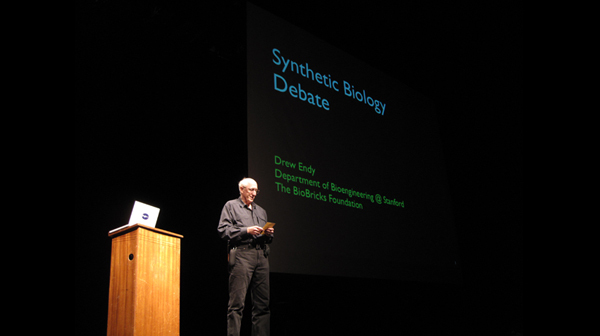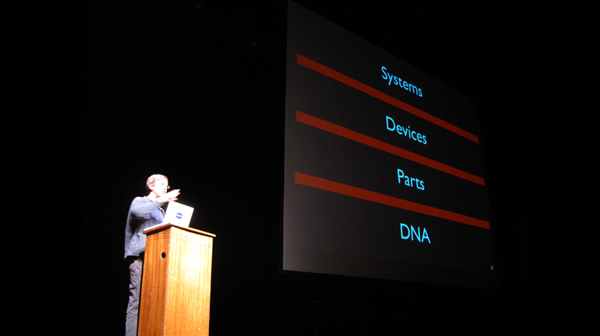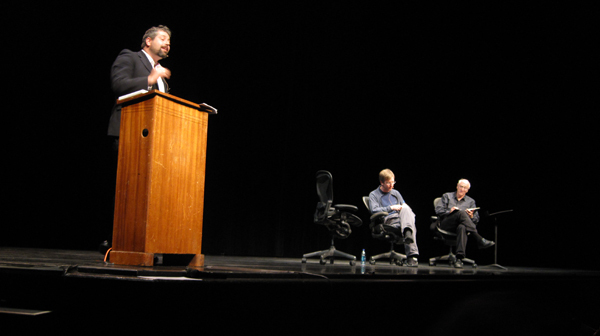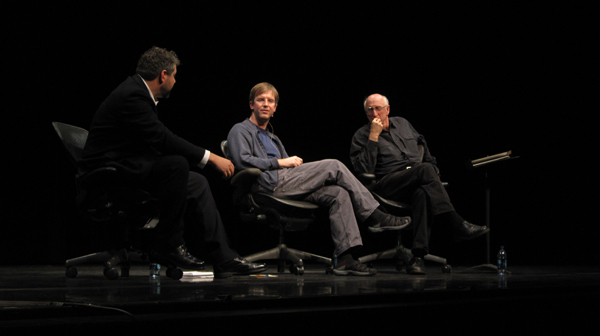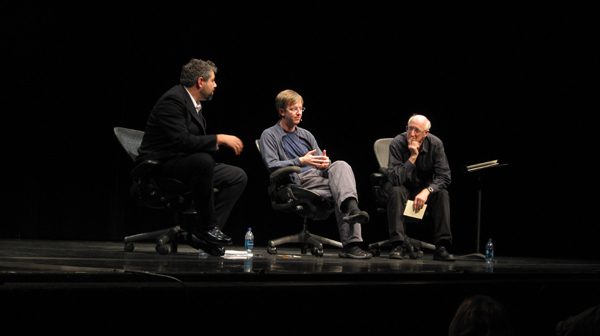Long Now Seminar on Synthetic Biology
Posted on Tuesday, November 18, 2008
Another great Long Now foundation seminar in San Francisco yesterday: Synthetic biology, its promises and perils. A lengthy 2-hour presentation/debate between Drew Endy, assistant professor at Stanford's Department of Bioengineering (middle in below images) and Jim Thomas, Research Programme Manager and Writer with ETC group (left), moderated by Stewart Brand (right). Watch this rss feed for the mp3 audio file of the debate to come online. Here is Stewart's recap of yesterday's event:
"I want to develop tools that make biology easy to engineer," Drew Endy began. The first purpose is better understanding fundamental biological mechanisms through "learning by building." The toolkit of Synthetic Biology starts with DNA construction and ascends through DNA parts, to devices, to standardized systems. An organism's DNA code, and therefore the organism, can be digitally uploaded, stored, distributed, and downloaded. Life forms are programmable. So far 3,500 standard "BioBrick" parts have been developed for free distribution, and the number is growing geometrically. The number of amateur and student bioengineers also is growing geometicallly."There are 20,000 edible plant species," Endy noted. "At present we eat only 30." Synthetic biology can help diversify agriculture. Or how about engineering a gourd that can grow into a living house?
Endy concluded with five questions... Should teenagers practice genetic engineering? (Yes.) Should military weapons involve biotechnology? (No.) Should BioBrick parts be patented or freely shared? (Free.) Will biohackers be good or bad? (Good, if we help.) Should genetic engineers sign their work and publish it? (Yes.)
Jim Thomas asked Endy how he would defend against commercial interests locking up Synthetic Biology with patents? Endy said the best hope is building an open-source community that grows faster than businesses and out-innovates them.
Thomas began his statement by pointing out that it usually takes a whole generation to understand a new technology, so he urges moving slowly and cautiously, but Synthetic Biology is advancing at breakneck speed, and the window of opportunity to have effective public discussion and control is closing.He cited the history of synthetic chemicals, which began in mid-19th century. The technology quickly became highly concentrated in an oligarchy of monopolistic companies, and then it was easliy commandeered by government in wartime. I.G. Farben supplied the poison gas for the death camps. "Powerful technology in an unjust world is likely to exacerbate the injustice."
Thomas said he worries when he hears comments like, "Anything that can be made by a plant can be made by a microbe." If that's played out, it means the death knell for everyone who works in agriculture, a vast economic restructuring. There's so much novelty coming so fast from Synthetic Biology, no predictive models or regulatory models can hold them. He recommends these new tools be strictly contained so there is no release of new life forms into the biosphere, and there should be no commercialization of the technology at all.
Endy asked Thomas if it's okay to make anything in a bioreactor vat? Thomas said, "Yes, beer."
For different reasons, both debaters wanted to see Synthetic Biology kept from domination by commercial patents. For Thomas, it would lead to unjust monopoly answering only to profit. For Endy, it would paralyze open-ended research.
--Stewart Brand
With me were 2 great NASA Ames collegues, Deborah Bazar (working on securing NASA Ames' role in the emerging Green Tech industry here in the Valley) and John Cumbers, a synthetic biologist himself, researching the potential of synthetic biology for sustainable space exploration (read: designing microbes that will be used for In Situ Resource Utilization (ISRU) on the moon, Mars and/or asteroids for the production of oxygen and other consumables required to sustain human life). John invited me for a tour of his lab here at NASA Ames so with some luck I'll be able to post some more insights later this week about this fascinating emerging technology and NASA's interest in it.
